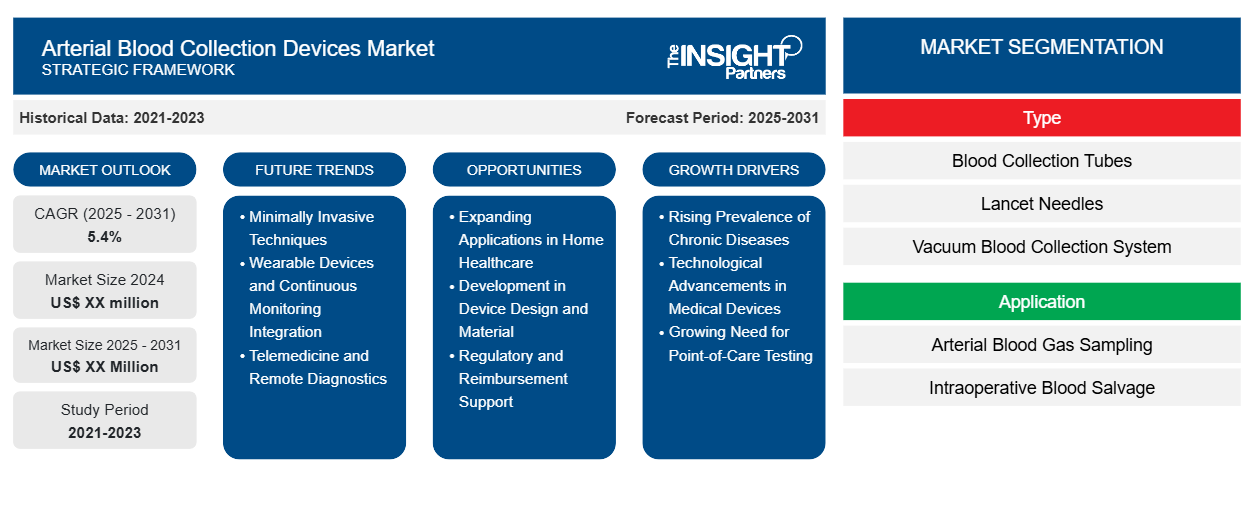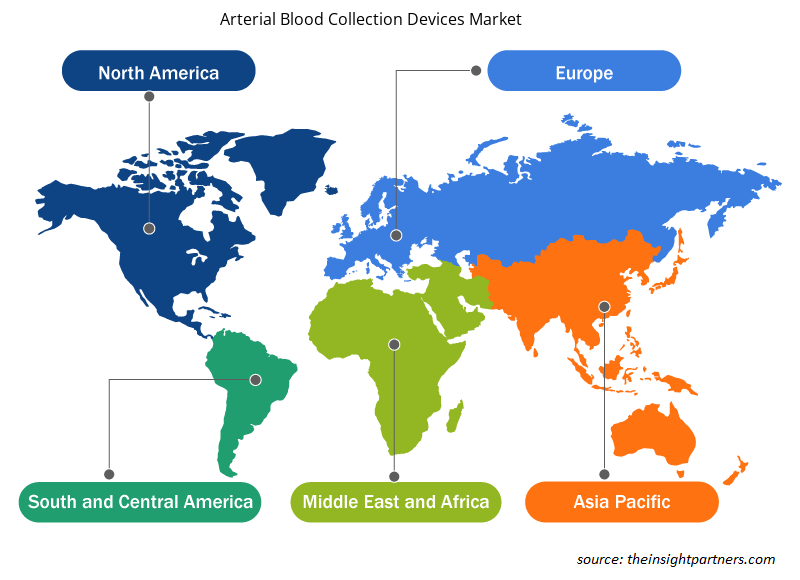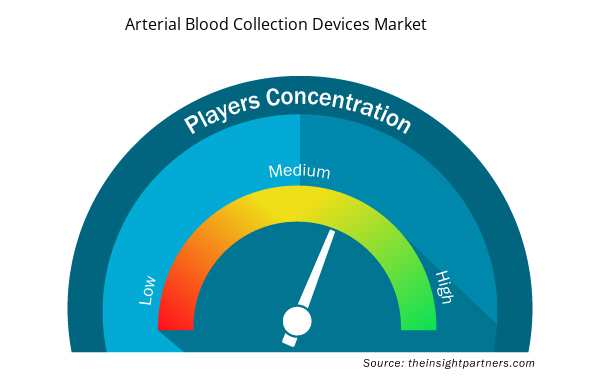The Arterial Blood Collection Devices Market is expected to register a CAGR of 5.4% from 2025 to 2031, with a market size expanding from US$ XX million in 2024 to US$ XX Million by 2031.
The report is segmented by Type (Blood Collection Tubes, Lancet Needles, Vacuum Blood Collection System, Microfluidic System, Others). The report further presents analysis based on the Application (Arterial Blood Gas Sampling, Intraoperative Blood Salvage). The report is segmented by End User (Hospital, Clinics, Others). The global analysis is further broken-down at regional level and major countries. The Report Offers the Value in USD for the above analysis and segments.
Purpose of the Report
The report Arterial Blood Collection Devices Market by The Insight Partners aims to describe the present landscape and future growth, top driving factors, challenges, and opportunities. This will provide insights to various business stakeholders, such as:
- Technology Providers/Manufacturers: To understand the evolving market dynamics and know the potential growth opportunities, enabling them to make informed strategic decisions.
- Investors: To conduct a comprehensive trend analysis regarding the market growth rate, market financial projections, and opportunities that exist across the value chain.
- Regulatory bodies: To regulate policies and police activities in the market with the aim of minimizing abuse, preserving investor trust and confidence, and upholding the integrity and stability of the market.
Arterial Blood Collection Devices Market Segmentation
Type
- Blood Collection Tubes
- Lancet Needles
- Vacuum Blood Collection System
- Microfluidic System
- Others.
Application
- Arterial Blood Gas Sampling
- Intraoperative Blood Salvage
End User
- Hospital
- Clinics
- Others
Geography
- North America
- Europe
- Asia-Pacific
- South and Central America
- Middle East and Africa
Customize This Report To Suit Your Requirement
You will get customization on any report - free of charge - including parts of this report, or country-level analysis, Excel Data pack, as well as avail great offers and discounts for start-ups & universities
Arterial Blood Collection Devices Market: Strategic Insights

- Get Top Key Market Trends of this report.This FREE sample will include data analysis, ranging from market trends to estimates and forecasts.
Arterial Blood Collection Devices Market Growth Drivers
- Rising Prevalence of Chronic Diseases: Chronic conditions such as cardiovascular diseases, diabetes, respiratory disorders, and kidney diseases have become the most prevailing problems at the world level, which increases the demand for monitoring blood gases frequently and accurately. The most critical conditions that require arterial blood gas analysis include managing COPD, heart failure, and complications of diabetes. Arterial blood collection devices are therefore required as the prevalence of such disorders is heightened due to frequent and precise monitoring.
- Technological Advancements in Medical Devices: Medical technology remains a catalyst for innovation in blood collection devices. Improvements toward better precision, safety, and user-friendliness in blood collection devices remain ongoing enhancements in the market. Improved needle technology, the availability of integrated sensors, and computerized systems that analyze blood gases can make arterial blood collection more efficient and accurate. Such progress reduces the extent of patient discomfort and complications arising from the procedure, thus more widely applied in inpatient as well as outpatient settings.
- Growing Need for Point-of-Care Testing: The utilization of point-of-care diagnostic devices is increasing, especially within accident and emergency and critical care environments, which enhances the demand for arterial blood collection devices. For patients with critical conditions, healthcare professionals need a rapid response time, so immediate blood gas analysis has become a need. Speed, ease of use, and convenience remain drivers for POC testing devices, and these advantages will continue to fuel demand for such products.
Arterial Blood Collection Devices Market Future Trends
- Minimally Invasive Techniques: The increased need for safe and minimally painful arterial blood collection techniques has led to the development and adoption of newer, minimally invasive techniques. Conventional arterial blood collection is painful and technically demanding, especially in very small or inaccessible arteries. New devices are being developed with the purpose of minimizing the patient pain and trauma while at the same time being easy to use on the part of clinicians. Such devices also vary from micro-needle and microneedle-based to robotic and automated collection devices.
- Wearable Devices and Continuous Monitoring Integration: Wearable medical devices and continuous monitoring systems are increasingly employed in managing chronic conditions requiring continuous measurement of blood gases. Wearable devices, now integrated into arterial blood collection technology, provide continuous, real-time monitoring of arterial blood gases (ABGs) without any need for repeated blood draws. This trend aligns with the greater movement health care is assuming-to become more personal and preventive-that allows a patient to monitor health metrics at home and share those data points with health care providers.
- Telemedicine and Remote Diagnostics: The advances in telemedicine and remote healthcare services that were widely implemented because of the pandemic create a sustained demand for in-home diagnostic devices. Arterial blood collection devices are the latest adaptation being brought into the home and used for testing and telemedicine diagnostics. The increasing popularity of remote or telehealth consultations implies that the future of the diagnostic equipment industry will be such that people can carry out blood gas analysis from the comfort of their homes.
Arterial Blood Collection Devices Market Opportunities
- Expanding Applications in Home Healthcare: A very rapidly expanding home healthcare market coupled with the trend toward patient-centric care offer substantial opportunities for arterial blood collection devices specially adapted for use in the home. Devices that allow patients to obtain a sample from their own arm for blood gas testing and to have the results transmitted back to healthcare providers decrease hospital visits and improve monitoring for chronic conditions over the long term. Companies will seize this market by developing user-friendly, safe, and accurate devices designed to answer both the needs of patients and caregivers.
- Development in Device Design and Material: The growing demand for more efficient and patient-friendly devices opens the chance for innovation by companies working within arterial blood collection devices. Creating ergonomic, lightweight, and biocompatible materials in devices can help to mitigate the sufferings of patients and increase the efficiency of blood collection. Such development can also be implemented in needle and tube materials as well as collection apparatuses to raise the safety levels and lower chances of infections, thus becoming a plus to manufacturers.
- Regulatory and Reimbursement Support: Most health sectors in most countries are currently emphasizing quality improvement in care. There is a big opportunity for advantageous regulatory and reimbursement policies towards arterial blood collection devices. The governments and health organizations of most countries are supporting advanced diagnostic tools and technologies that may serve as driving forces to companies in investing in high-end devices. In addition, the increasingly liberalized processes of approval and reimbursement policies for blood collection and diagnostic devices in the market may offer much opportunity for growth.
Arterial Blood Collection Devices Market Regional Insights
The regional trends and factors influencing the Arterial Blood Collection Devices Market throughout the forecast period have been thoroughly explained by the analysts at Insight Partners. This section also discusses Arterial Blood Collection Devices Market segments and geography across North America, Europe, Asia Pacific, Middle East and Africa, and South and Central America.

- Get the Regional Specific Data for Arterial Blood Collection Devices Market
Arterial Blood Collection Devices Market Report Scope
| Report Attribute | Details |
|---|---|
| Market size in 2024 | US$ XX million |
| Market Size by 2031 | US$ XX Million |
| Global CAGR (2025 - 2031) | 5.4% |
| Historical Data | 2021-2023 |
| Forecast period | 2025-2031 |
| Segments Covered |
By Type
|
| Regions and Countries Covered | North America
|
| Market leaders and key company profiles |
Arterial Blood Collection Devices Market Players Density: Understanding Its Impact on Business Dynamics
The Arterial Blood Collection Devices Market market is growing rapidly, driven by increasing end-user demand due to factors such as evolving consumer preferences, technological advancements, and greater awareness of the product's benefits. As demand rises, businesses are expanding their offerings, innovating to meet consumer needs, and capitalizing on emerging trends, which further fuels market growth.
Market players density refers to the distribution of firms or companies operating within a particular market or industry. It indicates how many competitors (market players) are present in a given market space relative to its size or total market value.
Major Companies operating in the Arterial Blood Collection Devices Market are:
- Bio-Rad Laboratories, Inc.
- NIPRO Medical Corporation
- QIAGEN
- F. Hoffmann-La Roche Ltd
- Terumo Medical Corporation
Disclaimer: The companies listed above are not ranked in any particular order.

- Get the Arterial Blood Collection Devices Market top key players overview
Key Selling Points
- Comprehensive Coverage: The report comprehensively covers the analysis of products, services, types, and end users of the Arterial Blood Collection Devices Market, providing a holistic landscape.
- Expert Analysis: The report is compiled based on the in-depth understanding of industry experts and analysts.
- Up-to-date Information: The report assures business relevance due to its coverage of recent information and data trends.
- Customization Options: This report can be customized to cater to specific client requirements and suit the business strategies aptly.
The research report on the Arterial Blood Collection Devices Market can, therefore, help spearhead the trail of decoding and understanding the industry scenario and growth prospects. Although there can be a few valid concerns, the overall benefits of this report tend to outweigh the disadvantages.
- Historical Analysis (2 Years), Base Year, Forecast (7 Years) with CAGR
- PEST and SWOT Analysis
- Market Size Value / Volume - Global, Regional, Country
- Industry and Competitive Landscape
- Excel Dataset



Report Coverage
Revenue forecast, Company Analysis, Industry landscape, Growth factors, and Trends

Segment Covered
This text is related
to segments covered.

Regional Scope
North America, Europe, Asia Pacific, Middle East & Africa, South & Central America

Country Scope
This text is related
to country scope.
Frequently Asked Questions
Blood Collection Tubes segment, by type, dominated the market in 2023.
North America region dominated the Arterial Blood Collection Devices market in 2023.
Expanding Applications in Home Healthcare act as a opportunity for growth of the market in forecast period.
The Arterial Blood Collection Devices Market is estimated to witness a CAGR of 5.4% from 2023 to 2031
The major factors driving the Arterial Blood Collection Devices market are:
1. Rising Prevalence of Chronic Diseases
2. Growing Need for Point-of-Care Testing
Players operating in the market are Bio-Rad Laboratories, Inc., NIPRO Medical Corporation, QIAGEN, F. Hoffmann-La Roche Ltd., Terumo Medical Corporation, Thermo Fisher Scientific, Inc., BD, Medtronic Plc., Narang Medical Ltd., Greiner Bio-One
Trends and growth analysis reports related to Life Sciences : READ MORE..
1. Bio-Rad Laboratories, Inc.
2. NIPRO Medical Corporation
3. QIAGEN
4. F. Hoffmann-La Roche Ltd
5. Terumo Medical Corporation
6. Thermo Fisher Scientific, Inc.
7. BD
8. Medtronic plc.
9. Greiner Bio-One
10. Narang Medical Ltd.

 Get Free Sample For
Get Free Sample For